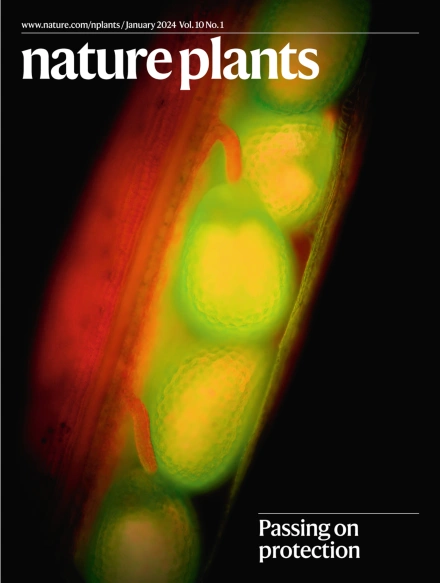The chloroplast-targeted long noncoding RNA CHLORELLA mediates chloroplast functional transition across leaf ageing via anterograde signalling.
IF 13.6
1区 生物学
Q1 PLANT SCIENCES
引用次数: 0
Abstract
The transition from chloroplast biogenesis to degeneration during leaf senescence is critical for plants' fitness, as it facilitates the relocation of nutrients to reproductive organs1-3. However, it remains largely unknown how the timing of this transition is regulated by the coordination between chloroplasts and the nucleus4,5. Here we describe the regulatory mechanism underlying this transition in Arabidopsis thaliana. CHLOROPLAST-RELATED LONG NONCODING RNA (CHLORELLA) is highly co-expressed with genes supporting chloroplast function during leaf development. Leaves lacking CHLORELLA exhibit precocious senescence and reduced expression of chloroplast-associated genes, suggesting that CHLORELLA helps maintain chloroplast function. Mechanistically, CHLORELLA transcripts are translocated into chloroplasts and contribute to the accumulation of the plastid-encoded RNA polymerase complex. As leaves age, the expression of CHLORELLA decreases, leading to reduced plastid-encoded RNA polymerase accumulation and diminished transcription of photosynthesis-related genes, which may trigger leaf senescence. Moreover, CHLORELLA expression is activated by GOLDEN2-LIKE1 and GOLDEN2-LIKE2, master regulators of chloroplast development6-8. Our study unravels a long-noncoding-RNA-based anterograde signalling mechanism that facilitates timely leaf senescence.叶绿体靶向长链非编码RNA CHLORELLA通过顺行信号介导叶片衰老过程中叶绿体功能转变。
叶片衰老期间叶绿体生物发生到退化的转变对植物的适应性至关重要,因为它促进了营养物质向生殖器官的转移1-3。然而,这种转变的时间是如何通过叶绿体和细胞核之间的协调来调节的,这在很大程度上仍然是未知的。在这里,我们描述了拟南芥中这种转变的调控机制。叶绿体相关长非编码RNA (CHLORELLA)在叶片发育过程中与支持叶绿体功能的基因高度共表达。缺乏CHLORELLA的叶片表现出过早衰老和叶绿体相关基因表达减少,表明CHLORELLA有助于维持叶绿体功能。从机制上讲,小球藻转录本被转运到叶绿体中,并有助于质体编码RNA聚合酶复合物的积累。随着叶片老化,小球藻表达减少,导致质体编码RNA聚合酶积累减少,光合作用相关基因转录减少,可能引发叶片衰老。此外,叶绿体发育的主要调控因子GOLDEN2-LIKE1和GOLDEN2-LIKE2可激活小球藻的表达6-8。我们的研究揭示了一个基于长非编码rna的顺行信号机制,促进了及时的叶片衰老。
本文章由计算机程序翻译,如有差异,请以英文原文为准。
求助全文
约1分钟内获得全文
求助全文
来源期刊

Nature Plants
PLANT SCIENCES-
CiteScore
25.30
自引率
2.20%
发文量
196
期刊介绍:
Nature Plants is an online-only, monthly journal publishing the best research on plants — from their evolution, development, metabolism and environmental interactions to their societal significance.
 求助内容:
求助内容: 应助结果提醒方式:
应助结果提醒方式:


